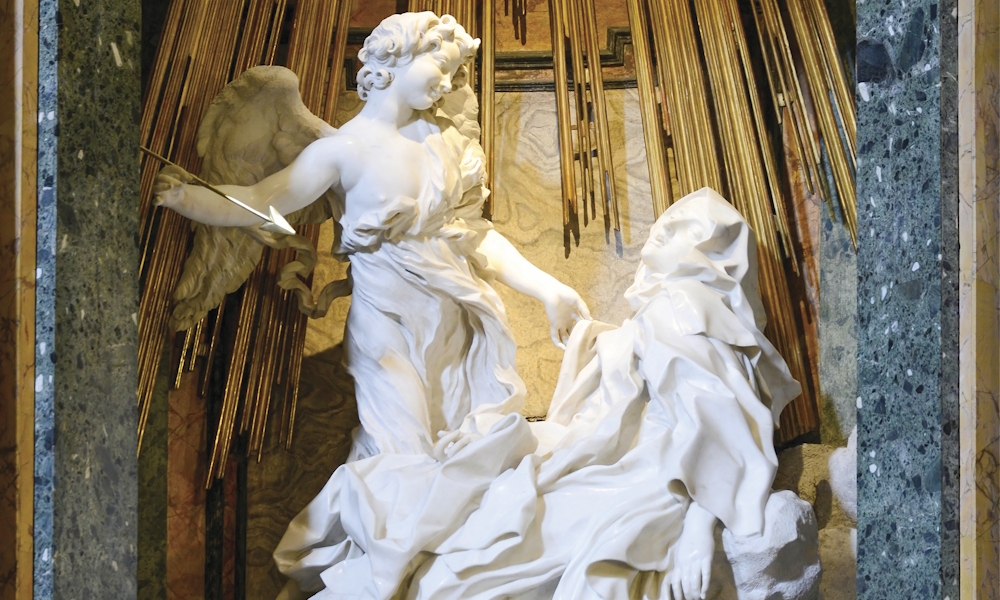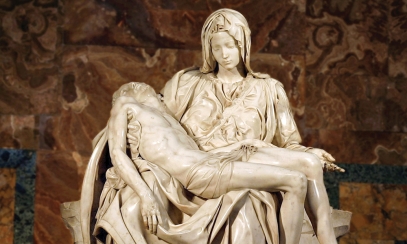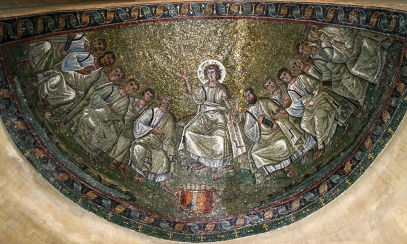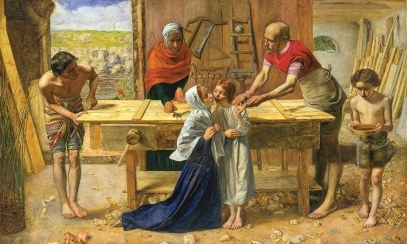
A glimpse into the holy longing of St. Teresa
One of the most significant works from the Italian Baroque period is the Ecstasy of St. Teresa by Gian Lorenzo Bernini. The sculpture is carved from a single piece of Carrara marble and was inspired by the writings of Teresa after a mystical experience in which she saw, “On my left, an angel appeared in human form.... In his hands I saw a golden spear and at the end of the iron tip I seemed to see a point of fire. With this he seemed to pierce my heart several times so that it penetrated to my entrails. When he drew it out, I thought he was drawing them out with it, and he left me utterly consumed by the great love of God … so excessive was the sweetness caused me by this intense pain that one can never wish it to cease, nor will one's soul be content with anything less than God.”
One of the most significant works from the Italian Baroque period is the Ecstasy of St. Teresa by Gian Lorenzo Bernini. The sculpture is carved from a single piece of Carrara marble and was inspired by the writings of Teresa after a mystical experience in which she saw, “On my left, an angel appeared in human form.... In his hands I saw a golden spear and at the end of the iron tip I seemed to see a point of fire. With this he seemed to pierce my heart several times so that it penetrated to my entrails. When he drew it out, I thought he was drawing them out with it, and he left me utterly consumed by the great love of God … so excessive was the sweetness caused me by this intense pain that one can never wish it to cease, nor will one's soul be content with anything less than God.”
The overall composition shows rays coming down from heaven, lit by a hidden oculus that allows natural light to flood the sculpture from above. Teresa is perched almost perilously on a cloud, with her left leg hanging off. Clouds are a device Bernini used to suggest a place somewhere between heaven and earth. While the angel and Teresa are deeply carved and beautifully polished, the cloud and angel wings are left rough, implying a numinous presence that is not quite visible. And while Teresa seems completely limp, she is held up by the ever so slight touch of the angel’s left hand.
The rapturous expression on Teresa’s face has often been described as too sensual, but I believe that is exactly the point. Throughout the Bible there are references to a sacred spiritual union, such as “As a young man marries a virgin, your Builder shall marry you; And as a bridegroom rejoices in his bride so shall your God rejoice in you.” (Is 62:5) The idea of an earthly marriage can lead us to something of an understanding of human-divine interdependence.
It is as if Teresa has not only abandoned her ego, but she has also offered her body, soul and spirit to Jesus, who referenced himself as the Bridegroom. This sculpture represents her mystical marriage to Christ and the fullness of God. If we say that Christ is the bridegroom and the church is his bride, and since we are the church, what else could this mean for us? St. Teresa had a deep conversion experience, as did St. Paul on the road to Damascus. Paul manifested his deep love for Christ differently, but surely his life reflected this same spiritual union or divine serenity.
In her “Loving Colloquy” Teresa writes
What I fear most is losing thee,
A soul within its God now hidden,
whatever else should it desire,
but to e’er greater love aspire,
and in that love remain all hidden,
returned anew into love’s fire?
Is this not the holy longing we each feel at the depths of our soul, even if we might describe it differently?
A copyright-free autobiography of St. Teresa of Avila can be found at www.carmelitemonks.org/Vocation/teresa_life.pdf
Mark Landers is a parishioner of St. Austin Parish in Austin and a member of the Diocesan Fine Arts Council. He and his wife, Christina, own and operate Landers’ Studio, a woodworking shop and design studio. They design and construct custom furniture and high-quality architectural piecework.




